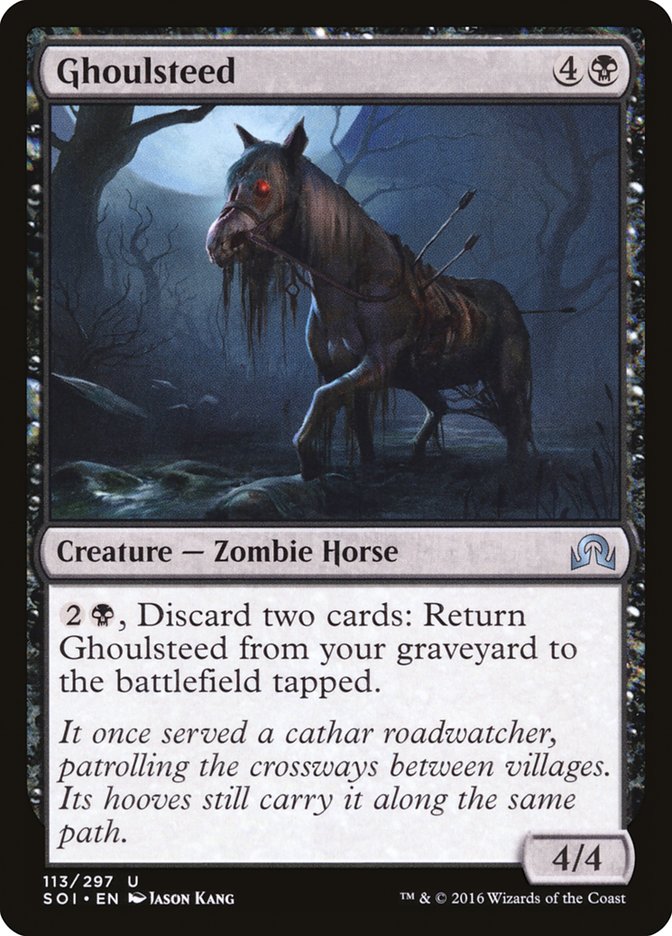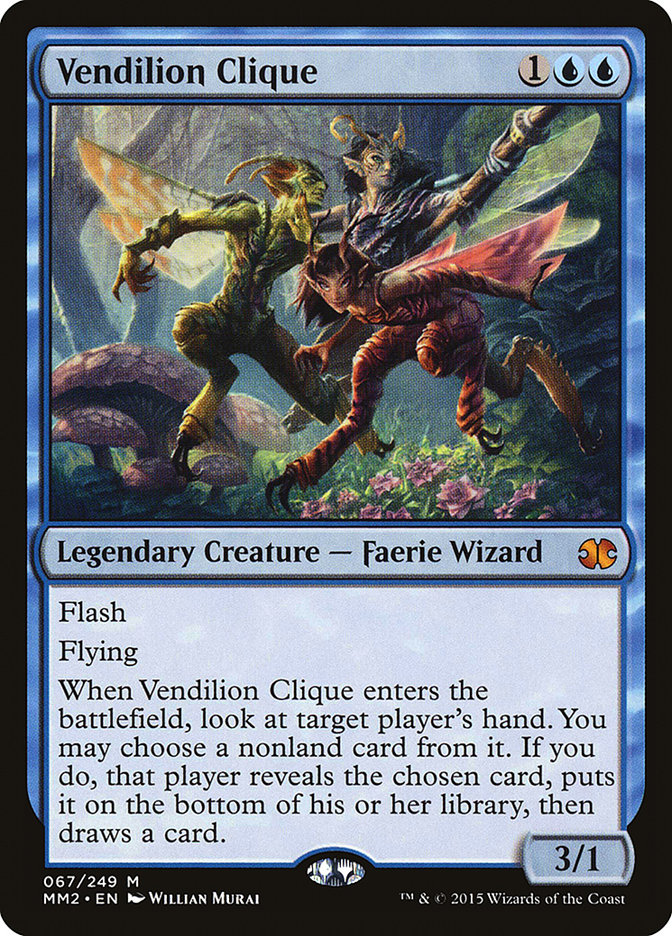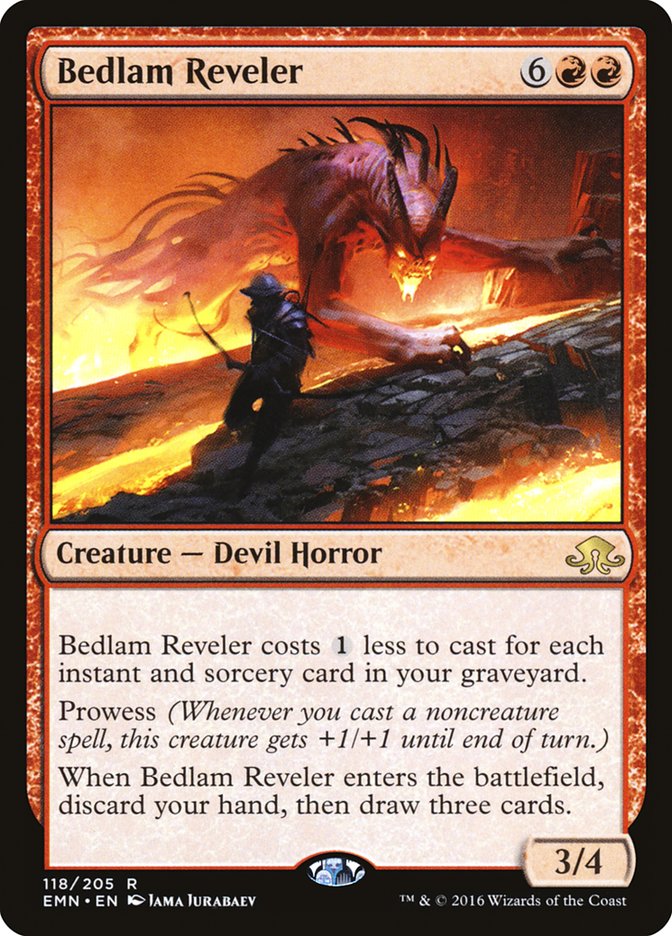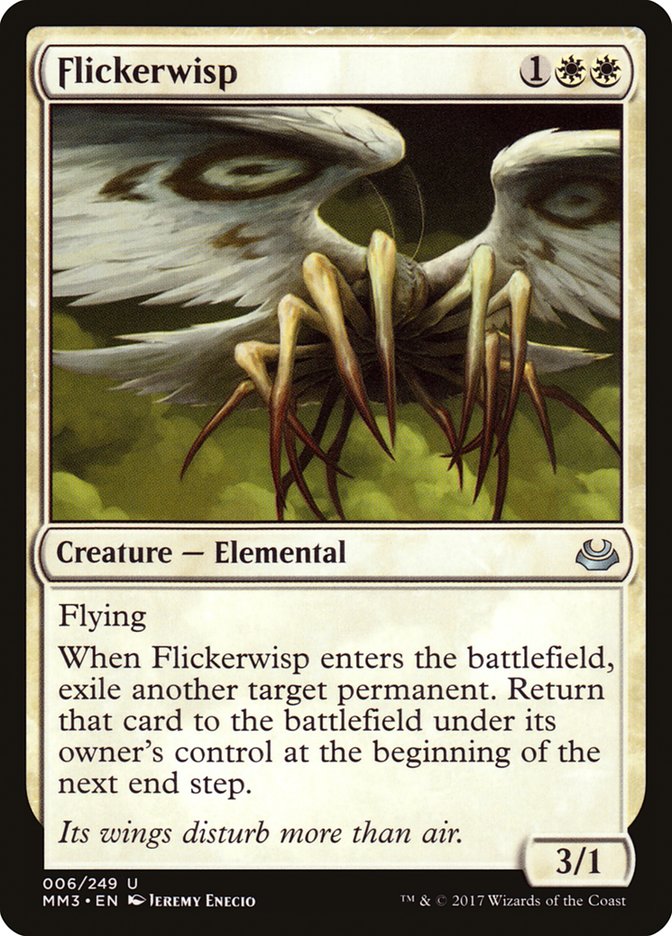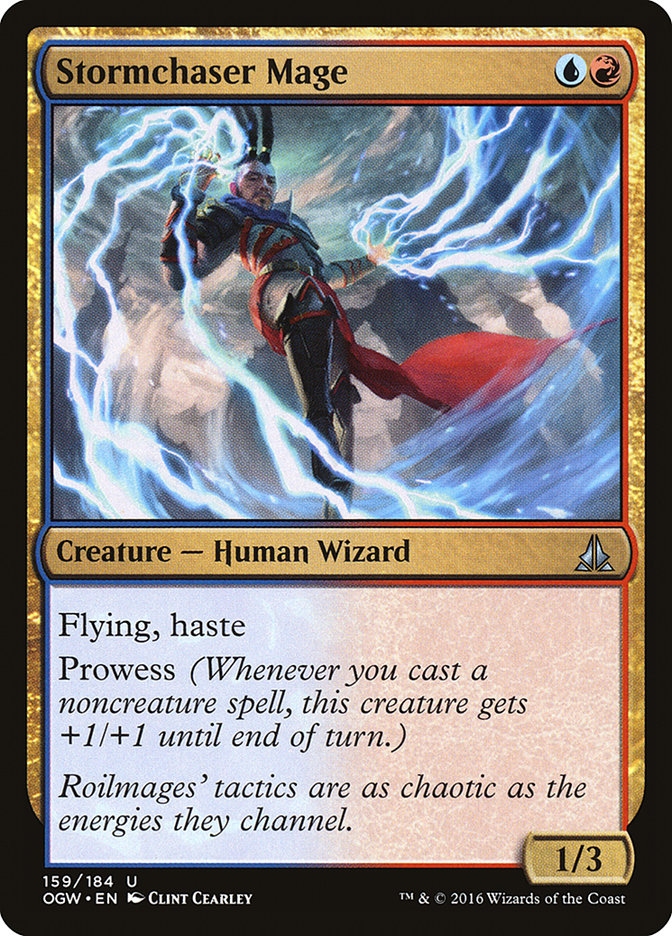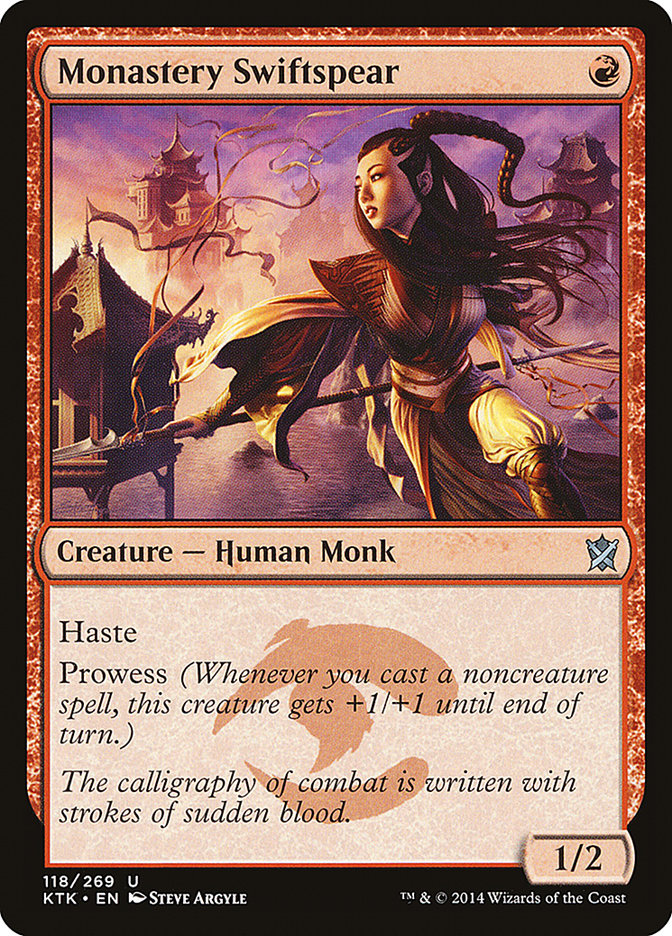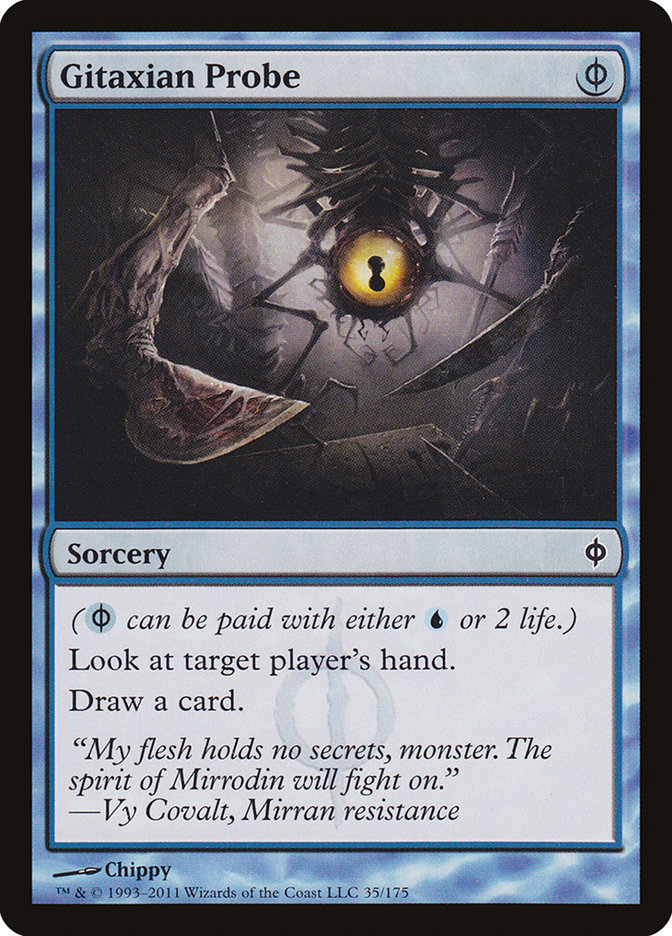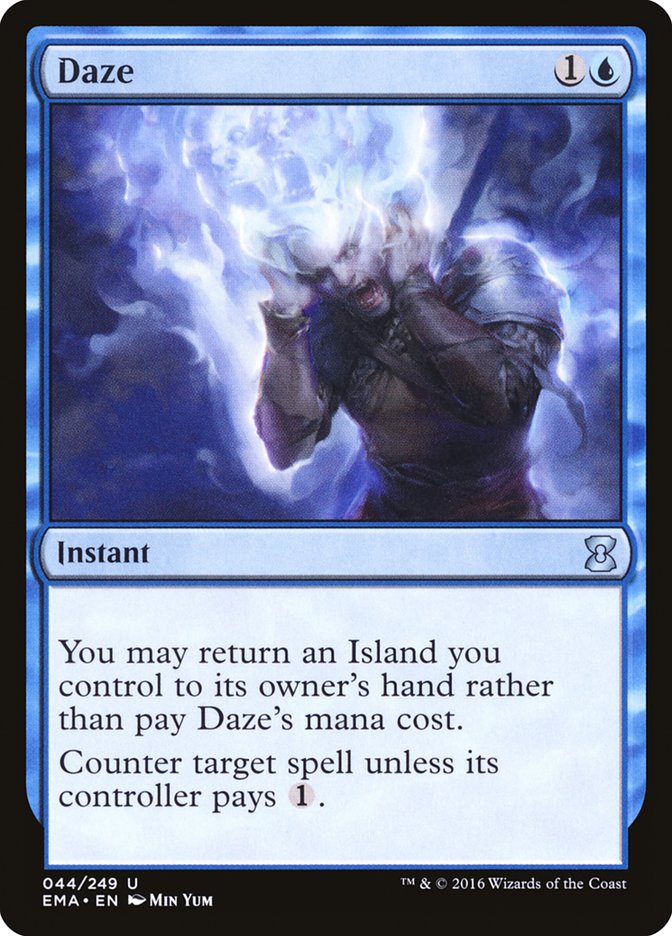First there was the primer. Then came the game analysis. Today comes the guide on posturing and sideboarding with U/R Prowess in Legacy; this horse isn’t dead, so we’re gonna keep beating it.
“Please stop hitting me.”
For those new to the party, the U/R Prowess deck is a hyper-aggressive take on the tempo-oriented Delver archetype. The deck tends to adopt a type of Burn-esque role by playing more red spells than traditional versions of the deck, eschewing Wasteland to make sure spells can be cast at proper times.
The biggest draw to U/R Prowess over a Delver deck lies primarily in the fair matchups. U/R Prowess is going to shine against Shardless Sultai, Death and Taxes, and other Delver decks due to the ability to close a game at the drop of a hat. Rather than punishing greedy manabases with the grind associated with Wasteland, this deck takes a much more permanent approach with Price of Progress.
In many respects, the deck functions like the Patrick Sullivan Mono-Red special.
Spent the morning digging around for SCG Baltimore. Will be fun to dust off the dome shots one last time. pic.twitter.com/qNiwR5WVEm
— Patrick Sullivan (@BasicMountain) February 7, 2017
There is one key difference in this deck and Sullivan’s: the blue cards. Daze, Force of Will, Spell Pierce, and Flusterstorm contribute to this deck having game against the unfair things that tend to happen in Legacy.

Picture: Patches O’Houlihan’s advice on piloting Burn against unfair decks.
All kidding aside, this weekend is #SCGWOR and I’m planning on playing a list within about five cards of this 75:
Creatures (13)
Lands (16)
Spells (31)

Most of the list is explained in the aforementioned primer article, but the biggest shift from there is the inclusion of Vendilion Clique over the second copy of Bedlam Reveler.
Bedlam Reveler is complicated in this deck. In almost every fair matchup, it is the best card in the deck… on turn 5. Before that point, it is miserable in multiples and the first copy is functionally a dead card until Prowess can empty its hand. Without a Brainstorm, the second copy isn’t anything more than a card to be discarded to the first.
Vendilion Clique fills the hole left by the removal of the second Bedlam Reveler. Changing the Bedlam Reveler to Vendilion Clique draws parallels to the shifting of Goblin Guide (from older U/R Delver decks) to Stormchaser Mage in this configuration. At the risk of sounding a bit garrulous, Vendilion Clique can do so many things for the deck that it feels that I’m doing it a disservice by not elaborating a bit.
- For starters, Vendilion Clique is an evasive threat. Against the fair creature decks, this is an enormous game. Being able to break through a Mother of Runes or Wirewood Symbiote that’s gumming up the ground is invaluable.
- Clique works as disruption coupled with a threat. I don’t really need to sing the praises of Vendilion Clique doing “Vendilion Clique things” too much, but picking a payoff card out of a combo player’s hand is a welcome addition to the deck.
- The Fae work as card filtering. One of the downsides of the Prowess deck is that the cards tend to be very polar in value, either very good or very bad. Having the ability to turn a Chain Lightning into a different card against combo, or a Daze into something else versus Cavern of Souls, is a relatively common line to take.
- “Countering” Miracles is likely the most important mode of Vendilion Clique. When the Terminus or Entreat the Angels is revealed with the miracle trigger, it’s possible to respond with Vendilion Clique and tuck the spell in their deck before they have the opportunity to cast it. I’ve won countless games by unexpectedly dealing with a Terminus or Entreat the Angels that would’ve locked up the game otherwise.
Vendilion Clique isn’t the best card to do any one of the previously mentioned things, but the utility that comes along with the gaggle of Faeries puts it over the top and cements its slot in the deck.
Matchups
I try to avoid doing sideboarding guides, with the reason being that they provide a significantly more rigid structure than sideboarding tends to reward. Think of these as tips rather than a set of rules that must be followed. Great sideboarding comes from understanding how cards work in a matchup and how the opponent’s plan will match up with your own.
Miracles
Out:
In:
First off, we’ll address the elephant in the room. Miracles has been the best deck in Legacy for a long time, and having a plan against it is important.
Daze is getting the axe because U/R Prowess can’t kill the opponent before turn 5 or 6 through disruption, and Daze doesn’t translate well to that phase of the game. Gitaxian Probes are being cut because they get locked down by Counterbalance / Sensei’s Divining Top and don’t provide anything proactive to the deck unless there is already a threat on the table. The spells being brought in are primarily to answer Counterbalance or provide a threat that Terminus can’t get off the battlefield.
On the play, it is reasonable to leave in some number of Dazes and shave either the fourth Gitaxian Probe or some number of Chain Lightning. This is one of the rougher matchups in the format, and I’m looking into testing Exquisite Firecraft to swing the matchup if possible.
While playing against the deck, if they don’t have Counterbalance, try to sandbag creatures. Don’t let them two-for-one you with Terminus, and play patiently. Due to the density of haste creatures in this deck, most creatures will get in a few points of damage before the Miracles player has the opportunity to deal with them. If you force them to continuously answer your spells one-for-one, their higher land count, coupled with the bits of value they lose each time a creature deals damage to them, will put them in range of every burn spell being lethal.
Earlier in the game, it is correct to let Sensei’s Divining Top resolve. The amount of time and mana they have to sink into their Sensei’s Divining Top helps Prowess pull ahead and press an advantage. Later in the game, when there’s a glut of mana on the table, it is correct to counter Sensei’s Divining Top, if possible.
If and when the opponent assembles the Counter-Top lock, it’s best to have a single “big turn” where Prowess tries to burn Miracles out. Use a one-mana sorcery-speed card to bait them into tapping their Top to draw a card, and then respond to the activation with instant-speed one-drops that may otherwise be locked out by Counterbalance. If the opponent locks out one-mana spells, accept that they are effectively blanks and move on with your life. Construct a gameplan around the Stormchaser Mages getting bigger from countered single-mana spells later on. Winning through Counter-Top is hard, but it isn’t impossible.
Death and Taxes
Out:
In:
On the play, shave another Force of Will; on the draw, shave another Daze. The countermagic isn’t particularly exciting against the Cavern of Souls / Aether Vial deck, so giving our countermagic the axe is relatively intuitive. If the opponent is playing a nonbasic-land-heavy version of the archetype (read: multicolor, Kor Haven, or Horizon Canopy), it is also reasonable to cut all of the countermagic and bring in the third Price of Progress.
The first thought against a deck that plays ten basic lands is to shave Price of Progress, but post-sideboard, U/R Prowess is just trying to do its best impression of a Burn deck. This means that the goal of the deck is to count to twenty as quickly as possible, and Price of Progress being a Flame Rift is going to be good enough nine times out of ten.
Against Death and Taxes, it’s important to understand which creatures are must-kill threats. Not everything needs to die on the spot, and understanding what can stick around (and what can’t) is important. Answering Stoneforge Mystic and Mother of Runes with burn is important; those will close the game over its course. Sanctum Prelate needs to be answered almost immediately.
Flickerwisp can be outsized with Stormchaser Mage and Monastery Swiftspear. With proper sequencing, Spirit of the Labyrinth’s impact can be mitigated. Thalia, Guardian of Thraben can be beaten.
Flying is important in this matchup, and closing the game before Equipment get out of control is a must. Value Smash to Smithereens very highly in this matchup, as it’s likely one of the best two or three cards that the deck can offer. Finding a Smash to Smithereens or sticking a Sulfuric Vortex is likely going to be necessary to beat an average draw from Death and Taxes; use cantrips accordingly.
Grixis Delver / Gurmag Angler
Out:
In:
This matchup is probably my favorite to play in today’s Magic. U/R Prowess feels slightly favored, but not by very much. Generally speaking, Prowess is going to be the aggressor and try to close the game before Young Pyromancer and Gurmag Angler can take over, but there are draws that require a more conservative line of play from Prowess.
Force of Will is cut from the deck because there isn’t any kind of enormous payoff card that’s worth spending two cards to counter. Our own Jim Davis recently had an article on Premium on the most overrated cards in Magic, and he offers a fantastic bit on why Force of Will isn’t necessary in most “fair” mirrors. That line of thinking applies here, and his article does a great job of explaining it.
Gurmag Angler is the easiest way to lose a game. Everything else can be outsized and answered over time, but outside of Thunderous Wrath and Daze, there aren’t any clean answers to Gurmag Angler. Keeping the Zombie Fish off the table makes most games relatively cut-and-dried, albeit a slog, in Prowess’s favor.
Sultai/Temur Delver-‘Goyf decks
Out:
In:
Most of the aforementioned theory applies in this section, but instead of Young Pyromancer, the two-mana creature of choice is Tarmogoyf. Most of what is said about Gurmag Angler can also be said about Tarmogoyf. It’s hard to answer and relatively difficult to race as well. Instead of using Izzet Staticaster to answer a horde of 1/1 Elemental tokens, this sideboarding configuration plans to get ’em with the Submerge trick from my article last week.
Reanimator
Out:
In:
Bad cards out, good cards in. Bedlam Reveler is better in games that will go long or be grindy. Price of Progress is bad because combo decks won’t have very many lands on the battlefield. Thunderous Wrath requires mana use on its caster’s turn. Chain Lightning is the least impactful card in the matchup. Everything coming in is meant to counter a spell.
Don’t be afraid to counter an early cantrip. It’s generally going to be better to counter enablers like Entomb than payoff cards, given the option. Countering an Entomb means that all of their Reanimates, Exhumes, and Animate Deads don’t do anything. The cards in combo decks don’t do anything until the pieces are in place to have an effect. Careful Study is a bit embarrassing if there isn’t a creature to discard, reanimation effects are bad without a creature in the graveyard, and so forth.
Against R/B Reanimator, Pyroblast isn’t necessary. Pyroblast generally will counter early copies of Brainstorm and Careful Study.
Be sure to develop a threat. Sometimes the shields must come down in order to do it, and that’s fine. The earlier you give the opponent a turn to try to combo, the fewer turns they’ve had to prepare and resources they have to try to put a big creature on the table. If Prowess isn’t progressing towards ending the game, playing draw-go isn’t an effective strategy. The game needs to end before the opponent can get a problematic creature on the battlefield.
Chalice of the Void Decks
I’m lumping a large number of decks together as a single section because the gameplans tend to be similar from deck to deck. Whether it’s Eldrazi, Mono-Red Stompy, Imperial Painter, or an Aggro Loam deck, Chalice of the Void decks tend to have a similar gameplan:
- Play a high number of nonbasic lands, either to play several colors or produce multiple mana from a single land.
- Stick some number of Trinispheres or permanents that make it harder to play Magic. Think Chalice of the Void, Sphere of Resistance, Trinisphere, and Blood Moon.
- Have a gameplan that involves sticking a few high-impact threats to close the game while the opponent tries to cobble together a way to cast their spells.
Looking at the cards in the deck is going to do a lot of work towards figuring out what cards to remove, but most the cards that could be brought in against these decks are:
Eldrazi
Dragon Stompy / All-In Red
Imperial Painter
Aggro Loam
Notice anything? Despite all being different decks with different colors and angles of attack, a lot of the cards that are coming in are similar. A lot of what goes into sideboarding is finding trends in play patterns and seeing how to attack that archetype, not just specific cards in the deck.
Sideboarding out cards isn’t much trickier. It just takes a little bit of extra thought. If the opponent has Cavern of Souls or if the game is going to drag for a long time, cut Dazes. If the opponent doesn’t have creatures, Chain Lightning is oftentimes going to be a Lava Spike that they can throw back at you. If the opponent is playing a mana denial-heavy strategy, shave some of the higher-mana cards. At first, it’s hard to get in the rhythm of thinking on your feet while sideboarding, but once the foundation is built, it improves your play a great deal.
Tips for Sequencing
It’s usually going to be correct to lead on Monastery Swiftspear. If the first turn is a single point of damage and the second turn has a cantrip, the Monastery Swiftspear will deal three points of damage. That’s the same amount as Delver of Secrets blind-flipping and crashing in. The difference is that the second turn could have a cantrip and a burn spell or the opponent could kill the first creature played, no matter what it is. In both of these cases, Monastery Swiftspear will deal more points of initial damage than Insectile Aberration will (in the context of those two turns).
Insectile Aberration also translates better to the late-game. It’s harder to block and rewards playing in conjunction with a cantrip to stack one’s deck. It’s hard to get in the habit of leading on a creature that isn’t Delver of Secrets, but I promise you that Monastery Swiftspear is generally going to be mathematically correct.
The exceptions to this rule are when the second turn is going to be exclusively creature spells or holding up reactive spells. In these cases, it is generally going to be better to lead on the Delver of Secrets and hope for a blind flip. Delver into Stormchaser Mage is slightly better than Swiftspear into Stormchaser.
In most matchups, Gitaxian Probe serves as a free enabler that deals damage and grants information. Learn to play it.
If it is the first turn of the match and you have Monastery Swiftspear plus Gitaxian Probe, save the Gitaxian Probe. If the opponent leads on Deathrite Shaman, it’s going to be better to have the Probe the following turn to punch through the two-toughness creature. It also grants an opportunity to get more damage out of Gitaxian Probe by casting an additional Prowess creature. Remember, each prowess creature on the battlefield effectively tacks a point of damage on every single noncreature spell cast. The most creatures on the battlefield, the more damage each spell is worth. Sequencing with Gitaxian Probe can make or break a game.
You are going to counter your own spells. Converting extra counterspells to damage happens more frequently with this deck than one would assume. Remember that Daze can also act as a “free spell” if it is helping reset a land on the battlefield. One of my favorite sequences in the deck is as follows:
1. Pay two life for Gitaxian Probe.
2. Float a blue mana with an Island.
3. Bounce an Island to cast Daze, targeting Gitaxian Probe.
4. Use the floating blue mana to pay for Daze.
5. Resolve Gitaxian Probe
This sequence effectively allowed the deck to make an extra Prowess trigger (and possibly filter mana, if a basic Island was tapped to pay for Daze while Volcanic Island was bounced for it) and deal damage to the opponent in a pinch.
First, go read this article.
Second, remember that you are regularly supposed to cast Brainstorm during your main phase. Triggering Prowess pre-combat and figuring out how much damage will be done is necessary for planning how to kill the opponent. The card may say “instant,” but it’s much better to think of it as a “sorcery with benefits.”
Legacy on the Horizon
#SCGWOR is this weekend, and it’s the last major single-player Legacy event for quite a while. The #ProwessGang is growing more and more by the week, even reaching overseas. What’s stopping you from sleeving up a pile of Modern-legal creatures and Legacy spells?
Drop a question or comment in the bottom if there’s something I can outline or input you have on the techniques listed in the article. The deck is constantly evolving, and learning the next direction it needs to go is exactly what I’m here for. If you’ll be at #SCGWOR, make sure and say hi!


